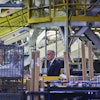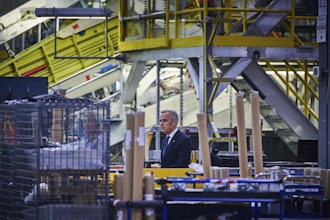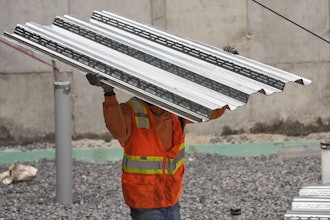
Panjiva is a search engine that enables buyers of products in one country to find suppliers of products in another country. It’s designed to make the lives of sourcing professionals easier. Sourcing being a very painful process, Panjiva is making it easier by profiling 750,000 companies around the world that make all different kinds of products and making those profiles searchable so that you can find the set of companies that are a potential fit as business partners for whatever product you are looking to source. They currently have 40 Fortune 500 companies that are subscribers, with over 2,500 companies in total utilizing their database. ID got a chance to speak with Josh Green, CEO of Panjiva, about their latest report, “The State of Global Trade in 2012,” and what’s behind the overall optimism driving the numbers for 2012.
Some highlights from the report:
- Suppliers and buyers vary when it comes to rising labor costs concerns – only 7 percent of suppliers cited rising wages in manufacturing hotspots as a biggest economic concern for 2012, compared to 26 percent of buyers.
- Buyers are shifting sourcing outside of China – Although 73 percent of buyer respondents currently source from China, 68 percent of them cited sourcing outside of China as “much more important” or “more important” in 2012 as compared to 2011. In fact, 34 percent of all buyers cited sourcing in new geographies as their top way of managing costs in the year ahead.
- Other Asian nations remain the top sourcing alternative to China – More than half (53 percent) of respondents pointed to other countries in Asia as where they plan to source goods beyond China.
- Buyers and suppliers both see opportunity in U.S. – Almost a quarter (24 percent) of buyers named the U.S. as a sourcing alternative to China. Further, 63 percent of overseas suppliers pointed to the U.S. as a region they will target for new business; suppliers were less interested in seeking to supply goods to Europe (56 percent) or China (41 percent)
To download a full copy of the report for free, visit www.panjiva.com.
On page 4 of the report, you note that larger companies (revenues over $100 million) are less optimistic about the year ahead than smaller ones. Why is this?
It’s a good question and is one of the real mysteries in the data. I think on some level smaller companies have had a tougher time surviving through the Great Recession. Those that did have really battened down the hatches and have stayed very lean and I think that they are finally seeing glimmers of hope. I think the excitement level is rising as people contemplate a global economic recovery. The larger companies have felt more secure all along and therefore this isn’t as significant of a change from their perspective. That’s my best guess.
On page 6, you said the buyers in the survey are interested in shifting their sourcing and want to find new places outside of China to supply their goods. Why is this? Public perception? Or is labor cost rising so much in China that they simply need to find somewhere else to source their goods?
It’s the second reason. Wages have been going up, if you go back in time a bit, there was a time when China just felt like the perfect sourcing destination. It has low tax, great infrastructure, and a seemingly inexhaustible pool of labor. I say seemingly, of course, because China, as big as it is, is finite and eventually so many people were manufacturing there and there was such significant growth that the Chinese wages started going up and as that happened, people have thought it would be great to find other places where the can again find lower wages. I think for the last couple of years it has been really accelerating in the last twelve months; people have been actively looking for places to go beyond China. The survey certainly indicates that effort continues.
You mention that they are still looking in Asia, in Thailand & Vietnam. Is that a trend that you predict will continue in the coming decade?
It seems the thing that is important to do is realize that there are real differences that emerge based on industry. I think in particular when you look at labor intensive manufacturing versus technology intensive manufacturing: in labor intensive manufacturing, labor cost really is the key driving factor of the cost structure, less so when it comes to technology manufacturing. It’s not surprising that places like the United States and China can still be competitive in technology intensive manufacturing, even though wages are higher than they are elsewhere. How does this play out? If you look at high tech manufacturing, China’s share of exports of things like computers and high end machinery, their share is actually growing despite the fact that wages are going up. If you look at labor intensive manufacturing, for things like apparel and textiles, that is where you are seeing real shifts and China losing share to places that have lower wage rates. Typically, the first place people are looking are other places in Asia. Although, if you look at the survey data, you do see the Western Hemisphere is at least on people’s radar. The US shows up as having 24% of people saying they will look at the US as a manufacturing option.
That data surprised me because of where the US placed on the scale: I was expecting them to place with much, much lower as far as interest goes. I expected Central and South America to be listed higher on there as opposed to the US or even Western Europe and Canada.
I agree with that. I think it was surprising how high the US was ranked as far as interest is concerned. I think the question becomes, what happens when people actually look? Yes the US will be considered, but will people actually find the capabilities that they need in the US? Will they find cost structures for them in the US? I think it’s hard to know the answer to that question, but my hunch is that when people take a close look, the answer will be no. The US is not ideal for them. There will narrow slices where it is a viable option, and I think this will be in high tech manufacturing where it will make sense to be in the US, but we are not talking about a broad-based shift towards the US.
Why do think people are even considering looking at the United States or the possibility of moving their manufacturing back here? Is that strictly a perception of people wanting to bring jobs back home, keeping in trend with the media buzz about “local sourcing” and “near-sourcing”?
Yes- I think that is right. There is a little bit of a buzz around it, a little nostalgia or excitement about the possibility of doing something that is good for the US economy. The way things used to be. Whether that translates into action is a different story.
On page 7 of the report, you talk about one of the main concerns of buyers and suppliers is to contain costs in the coming couple of years. How are they doing that?
At the top of the list is switching to new geographies and I think that is the reflection of companies being used to finding places where they can manufacture things cheaply thanks to low wage rates. That’s the experience in China for years and I think this is the expectation that you can more to a new geography with lower wage rates and instantly reap the cost savings. Here again, I do think there is likely to be sticker shock as people consider the broader array of costs. If you go beyond China you might find lower wage rates, but you might find weaker infrastructure which is going to increase transportation time and cost. You are also going to find, industry specific of course, that the workers in these regions just don’t have the skills that Chines workers have accumulated over the last decade and therefore not as productive. So you are paying a worker a lower wage rate, but they are producing less each day, ultimately your cost structure may stay the same or actually go up. There’s this hope that by moving to other geographies you will be able to either keep costs in check or drive costs down. But again, I think there may be some sticker shock.
One of the things that is most interesting is that it seems wage rates are a significant concern for buyers and not suppliers so much. It suggests that buyers are the one having to absorb the costs of rising wage rates. The suppliers have higher wage rates, but everyone on their block also has rising wage rates, and collectively that puts them in a stronger position with the buyers because their buyer can’t go down the block and get the product from another guy at a lower cost, because you just can’t right now. So I think the end result is that suppliers seem to have been able to pass along the increase in cost to the buyers. I think that is what lies behind a lot of buyers expressing concern about the rising wage rates and suppliers are not.
Does this hesitancy toward geographic movement also have to do with having to create your own facilities, investing more capital in a new location right away?
I think it depends on the company. I think there are companies that are very happy to innovate and lead the charge in moving into new geographies. They understand that it takes time but they have the time, they have the resources, and ultimately believe that the rewards will be significant enough to warrant the investment. That actually is a relatively smaller share of companies. A much larger share prefer to be fast followers. If they see that a region is popping up as a sourcing destination, I the infrastructure is starting to be in place, the capabilities are starting to develop, they want to go there quickly and reap not as many benefits as the people who were there first, but certainly reap some of the benefits. I think for that second group, they are going to wait and see. They are not going to jump in both feet and build new facilities and open new offices, etc. And it is a real issue, because if you look at most companies that have been serious about global sourcing, most of them built up significant operations, not just manufacturing operations, but sourcing operations and expertise in China. So you’ve got an office full of people in China that are responsible for finding and evaluating suppliers. Now you are asking them to look at other geographies. That is quite a shift to ask people to make. The other option is to set up a new office in different countries that you are looking at, but that of course requires a lot of money. It’s a tough change for an organization to make, to more from really focus on one geography to starting to think more broadly about a variety of geographies.
What do you see as trends then in the coming year? What should we look for as happening in the supplier/buyer sector?
I think in terms of high level trends, the outlook that we saw in the survey is pretty optimistic. The early trade data from this year seems to validate that optimism. You are seeing corporate buyers buying a lot more than last year. I think that bodes well for our economy. Secondly, you will see continuation of some of the things that we have seen in the past, i.e. people looking to diversify their sourcing beyond China. I think the third piece, which is a bit of a change compared to where we have been over the last couple of years has been a return to the US as a focus of exporters, in terms of markets that they want to serve. If you look at the second half of the last century, the US was where everyone wanted to sell. If you look at what happened in the Great Recession, you saw people pulling back a little bit and saying “You know what, maybe we shouldn’t be so dependent on the US market. Maybe we should be putting more into serving Europe or the Chinese market.” I think given the ongoing economic difficulties in Europe, and given that China seems to be slowing down a bit, you are seeing suppliers talking again of the US being the market that they care most about. That too is reflected in the survey data with the US showing up as the top region for targeting new customer acquisition.























